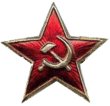Starshina
Starshina (Russian: старшина, IPA: [stərʂɨˈna] (![]()

The word originates from the Slavic word старший, starshij ("STAR-shee"), (lit. "older, more senior", from старый staryj "old")
Cossack Hetmanate
Among Cossacks in Ukraine, starshyna was a collective noun for categories of military officers and state officials. It derived from the offices in the Polish-Lithuanian Commonwealth. Sharshyna was subdivided into:
- General starshyna (Генеральна старшина), headed by Hetman (or Quartermaster General as acting Hetman)
- Quartermaster General
- Judge General
- Secretary General
- Adjutant General
- Treasurer General
- Ensign General
- Bunchuk General
- Regimental (Polkova) starshyna, headed by Polkovnyk (Colonel)
- Regimental Obozni (Quartermaster) (Ukrainian: Полковий обозний) - first Deputy Colonel. He was in charge of artillery and fortress fortifications. In the absence of a colonel he replaced him, but he was not authorized to issue universal orders (as opposed to the commanding colonel).
- Regimental Judge (Ukrainian: Полковий суддя) - was in charge of a civil court in the ratusha.
- Regimental Osavul (Ukrainian: Полковий осавул) - assistant Colonel in Military Affairs
- Regimental Khorunzhy (Ukrainian: Полковий хорунжий) - commander of the "Khorunzhy Cossacks", guarding the colonel and the starshina. He was in charge of regimental music and was responsible for keeping the khorugv (regiment flag).
- Regimental Chancellor (Ukrainian: Полковий писар) - secretaries at the ratusha. One was in charge of military affairs, and the other was civilian affairs
- Starshyna of hundred (Sotenna), headed by Sotnyk
- Sotenny otaman (Ukrainian: Сотенний отаман) - is the deputy sotnik. Implemented the duties of an obozni and a judge on a sotnia level.
- Sotenny Osavul (Ukrainian: Сотенний осавул) - assistant sotnik in Military Affairs.
- Sotenny Khorunzhy (Ukrainian: Сотенний хорунжий) - headed the sotnias flags.
- Sotenny Chancellor (Ukrainian: Сотенний писар) - is a secretary.
- Junior starshyna (Молодша старшина), headed by Otaman
Later, sometime after the Khmelnytsky's Uprising, it was also associated with the Ukrainian nobility which derived out of the officership and the Hetman.
Imperial Russia
Later, in the Tsardom of Russia and Imperial Russia, a volostnoy starshina was the chief of a volost (a rural administrative unit), in charge of the distribution of taxes, resolving conflicts within obshchina ("communes"), distributing community lands and military conscription. The rank of voiskovoi starshina (Войсковой старшина - "Starshina of the Army (Host)") was introduced into the ranks of the Imperial military in 1826, as the equivalent of a Lieutenant Colonel in the Cossack cavalry.
 Uzbek, stashina (аксакал) village Chodshagent (ru: Ходжагент), 1868, drawing by V.V. Vereshchagin.
Uzbek, stashina (аксакал) village Chodshagent (ru: Ходжагент), 1868, drawing by V.V. Vereshchagin.
Soviet Union and Russian Federation
The word Starshina gained its modern meaning in the Red Army, and is a hangover from the functional titles (like "brigade commander" or "assistant platoon leader") that were initially used by that force - the word literally means "senior". Most functional titles in the Red Army were abolished in 1942, but Starshina remained. Starshina was the highest non-commissioned rank in the Soviet Army until the reintroduction of the imperial rank of praporshchik in 1972.
In the Soviet Navy, the term "Starshina" was introduced between 1940 and 1943 as term equivalent to petty officer rank for every enlisted seaman above Matrose, 1st class. There was also created a rank equal to Starshina in the Army, but termed Glávnyj korabél'nyj starshiná (Chief Petty Officer of the ship) - this is the naval rank depicted in the tables below.
Insignia in the Red Army (1919-1946) and Soviet Armed Forces (1946-1991)
 |
 |
 |
 |
|||||||
| (1919—1924) | collar insignia (1924—1935) |
collar insignia (1935—1940) |
collar insignia (1941—1943) |
Technical troops (1943—1946) |
Ground combat troops (1943—1955) |
Ground forces (1955—1963) |
Air force,
airborne forces, air defence forces |
Navy (1924—1940) |
Navy (1955—1963) |
Air force, airborne forces (1963—1994) |
See also:
- Ranks and rank insignia of the Red Army 1918–1935, ... 1935–1940 and ... 1940–1943
- Ranks and rank insignia of the Soviet Army 1943–1955 and ... 1955-1991
Insignia in the Russian Federation
| Russian Federation | ||||||||
|---|---|---|---|---|---|---|---|---|
 |
 |
 |
 |
 |
 |
.png) |
 |
 |
| Strategic Missile Troops,
Airborne Forces
(service dress) |
Ground Forces (service dress) (1994—2010) |
Navy
(dress uniform) |
Air Force and Airborne Forces
kursant ("cadet") with rank of Starshina |
Field dress (1994—2010) |
Air force, airborne forces (2011—2015) |
Internal troops (1995—2016) Ministry of Emergency Situations (firefighters) (1995—2001) |
Militsiya, police,
some internal troops |
Navy
(dress uniform) |
See also:
- Ranks and rank insignia of the Russian Federation's armed forces 1994–2010
Other languages and countries


